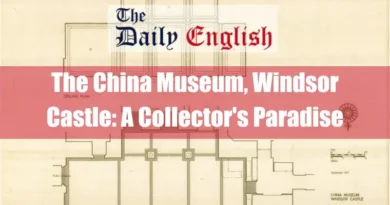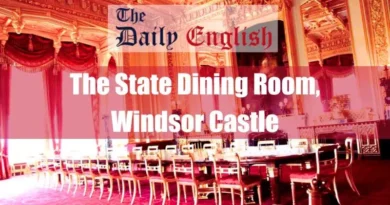The Grand Reception Room at Windsor Castle
Introduction
The Grand Reception Room at Windsor Castle is one of the castle’s most opulent and historically significant spaces, reflecting the grandeur of the British monarchy. Originally built in the 14th century as the Great Chamber, it evolved over centuries into a dazzling showcase of Regency luxury under King George IV. Renowned for its intricate Rococo design, lavish furnishings, and impressive scale, the room has been central in hosting royal ceremonies, state visits, and grand social gatherings. Its enduring importance lies in its ability to symbolise both the artistic achievement and historical legacy of the monarchy, making it a timeless representation of Britain’s regal heritage.
Key Takeaways
| Category | Details |
|---|---|
| Origins and Early Use | – Built in the mid-14th century under King Edward III. |
| – Originally known as the Great Chamber. | |
| – Served as a multi-functional space for court proceedings, war councils, and petitions. | |
| – Early designs likely included high ceilings, exposed beams, and stone walls, reflecting medieval simplicity. | |
| Transformation under George IV | – In the 1820s, King George IV commissioned Sir Jeffry Wyatville to redesign the room in the Rococo style. |
| – Key changes included: | |
| – Elaborate plasterwork featuring acanthus leaves and floral motifs. | |
| – Silk damask walls, large windows for natural light, and ornate fireplaces. | |
| – Lowering the floor to enhance the room’s scale and grandeur. | |
| – Renamed the Grand Reception Room, it became a symbol of Regency luxury. | |
| Use and Significance | – The room became central to Windsor Castle’s social and ceremonial life. |
| – Hosted lavish balls, state visits, and royal events like the Garter Investiture ceremony. | |
| – Notable occasions: | |
| – Winston Churchill’s investiture as a Knight of the Garter in 1946. | |
| – Accession Council of 1901, where Edward VII assumed the throne after Queen Victoria’s death. | |
| – The room’s versatility allowed for both grand celebrations and significant meetings. | |
| Architectural Features | – The room’s palatial dimensions include high ceilings and large windows that flood it with natural light. |
| – Key architectural elements: | |
| – Ornate doorways with architraves. | |
| – Richly decorated cove cornices and detailed skirting boards. | |
| Furnishings and Decor | – Designed primarily as a ballroom with features like: |
| – Ornate seating, elegant tables, and luxurious upholstered furniture. | |
| – Shimmering chandeliers and a central open space for dancing. | |
| – Decorative highlights include: | |
| – Silk damask wallpaper and woven tapestries. | |
| – Sculptures in marble or bronze. | |
| – A grand piano enhances the musical ambience. | |
| The 1992 Fire and Restoration | – In 1992, a devastating fire caused severe damage, destroying plasterwork, silk walls, and furnishings. |
| – A restoration project costing over £50 million meticulously recreated the room’s grandeur using traditional techniques. | |
| – New silk damask wallpaper was woven based on surviving fragments, and furniture was restored or replaced. | |
| The Grand Reception Room Today | – Fully restored, the room remains a symbol of royal history and British craftsmanship. |
| – It continues to host state events, investiture ceremonies, and public tours. | |
| – Visitors experience a glimpse of Britain’s regal past, showcasing a blend of history, artistry, and grandeur. |
History of the Grand Reception Room
Origins and Early Use
The Grand Reception Room’s story begins not with a ballroom waltz but with the clang of a blacksmith’s hammer. Originally built in the mid-14th century under King Edward III, the room served a far more practical purpose. Back then, it was known as the Great Chamber, a large, multi-functional space within the Upper Ward of the castle. Imagine bustling courtiers, not waltzing couples, filling the room. Here, Edward III likely held court, received petitions, and hosted important war councils.
The Great Chamber’s early design details are unknown from this period. However, historical records suggest a large, rectangular space with high ceilings, likely featuring exposed wooden beams and simple stone walls. It wouldn’t have been a lavish space by modern standards. Still, it was a significant room for its time, reflecting the power and status of the English monarchy.
Transformation under George IV
King George IV ascended the throne in 1820 and, unlike his more austere father, George III, craved a life of luxury and theatricality. He found Windsor Castle’s medieval interiors somewhat outdated for his tastes and desired a more dazzling showcase of the British monarchy’s grandeur. Enter Sir Jeffry Wyatville, a renowned architect tasked with transforming the castle.
Wyatville envisioned a radical transformation for the Great Chamber. The early 19th century saw the Rococo style’s peak popularity, characterized by its playful curves, intricate plasterwork, and lavish ornamentation. Wyatville embraced this exuberant aesthetic, discarding the Great Chamber’s unknown details in favour of the new design. Soaring ceilings were adorned with elaborate plasterwork featuring swirling acanthus leaves, shells, and floral motifs. Exposed beams, if present originally, were replaced by a richly decorated cove cornice, adding a touch of drama. Once bare stone walls were now swathed in shimmering silk damask, often adorned with portraits of royalty.
This transformation went beyond aesthetics. Wyatville completely reimagined the room’s functionality. Large windows were installed on one side, flooding the space with natural light and creating a more inviting atmosphere. Fireplaces were redesigned with ornate marble surrounds, adding warmth and grandeur. The most significant change, however, was the lowering of the floor level. This created a more impressive sense of volume, perfect for hosting lavish balls and social gatherings. The transformation was complete – the Great Chamber was reborn as the Grand Reception Room, a dazzling testament to the luxury and extravagance of the Regency era.
The Grand Reception Room in Use
With its dramatic makeover complete, the Grand Reception Room became the beating heart of Windsor Castle’s social scene. Imagine the scene: shimmering chandeliers glowed on polished floors as elegantly dressed ladies and gentlemen twirled in a waltz. The air buzzed with conversation, laughter, and the rhythmic strains of a Royal Philharmonic Society orchestra. The Grand Reception Room wasn’t just a ballroom; it was a stage for showcasing the wealth and power of the British monarchy.
Throughout the 19th and early 20th centuries, the room hosted various events. State visits from foreign dignitaries were often marked by lavish balls held in the Grand Reception Room. Queen Victoria, known for her fondness for hosting grand events, used the space for court presentations and celebrations like the Garter Investiture ceremony. Royal weddings, christenings, and even birthday celebrations for extended royal family members were held within these opulent walls.
The Grand Reception Room wasn’t just about frivolity; it also served a more serious purpose. On occasion, it was used for important meetings and ceremonies. For instance, following Queen Victoria’s death in 1901, the Accession Council, where her son Edward VII formally assumed the throne, was held in the Grand Reception Room. This juxtaposition of grand balls and solemn ceremonies highlights the room’s versatility and its enduring role as a witness to significant moments in British royal history.
One particularly interesting event held in the Grand Reception Room was the investiture ceremony for Winston Churchill as a Knight of the Garter in 1946. This prestigious ceremony, dating back to the 14th century, is the highest order of chivalry in Britain. The Grand Reception Room, with its opulent setting, provided a fitting backdrop for this recognition of Churchill’s immense contributions as Prime Minister during World War II.
Architectural Details

The Grand Reception Room’s grandeur isn’t simply a product of its opulent furnishings and decorations; it’s fundamentally rooted in its impressive architecture. Let’s delve into the key elements contributing to this magnificent space’s awe-inspiring presence.
Dimensions and Layout
Imagine yourself standing at the entrance of the Grand Reception Room. The sheer scale of the space would likely take your breath away. Stretching an impressive length and reaching a significant width, the room boasts a truly palatial feel. High ceilings add to the sense of grandeur. Large windows line one side of the room, bathing the space in natural light and offering a glimpse of the manicured castle grounds. This combination of generous dimensions and ample natural light creates an impressive and inviting atmosphere.
Architectural Elements
Step further into the room, and your eyes will be drawn to the architectural elements that elevate its design. The grand doorways, adorned with ornate architraves and carvings, serve as a fitting introduction to the abundant space beyond. Look upwards, and your gaze will meet the richly decorated cove cornice that frames the ceiling, adding a layer of visual interest and grandeur. Take note of the intricately moulded skirting boards that grace the base of the walls, further emphasising the room’s elegance and attention to detail. While seemingly simple, these architectural elements create a visually stunning, cohesive space.
Furnishings and Decor

The Grand Reception Room wouldn’t be the opulent spectacle it is without its exquisite furnishings and decorative elements. Imagine yourself transported back to a glittering ball. Crystal chandeliers cast a warm glow on the polished wood floor as guests mingle amidst a carefully curated collection of furniture and art. Let’s explore the key components that bring this grand space to life.
The Art of Furniture
The Grand Reception Room’s primary function as a ballroom is reflected in its furniture selection. Ornate seating arrangements line the walls, providing comfortable spots for guests during social gatherings. Elegant side tables, often featuring beautiful craftsmanship, add a touch of sophistication and offer convenient surfaces for refreshments or decorative objects. Scattered throughout the room, you might find intricately designed chairs and armchairs, upholstered in luxurious fabrics, offering additional seating options.
Central Stage for Grandeur:
Undeniably, the central space reserved for dancing takes centre stage. The absence of permanent furniture allows for the free flow of movement, which is essential for a grand waltz or a lively quadrille. Imagine the scene: elegantly dressed ladies twirling in their flowing gowns, their partners guiding them across the polished floor under the watchful gaze of portraits adorning the walls. The very arrangement of the furniture reinforces the Grand Reception Room’s primary function as a space for social gatherings and grand celebrations.
Beyond the Ballroom Essentials
The Grand Reception Room’s grandeur extends beyond the necessities of a ballroom. The walls, adorned with shimmering silk damask wallpaper, are further enriched by meticulously woven tapestries. These tapestries depict various subjects, potentially including historical scenes, mythological figures, or landscapes. Imagine the rich colours and intricate details of these tapestries, each adding a layer of cultural and artistic significance to the space.
Dotted around the room, you might also find sculptures crafted from marble or bronze. These sculptures depict a range of subjects, possibly including historical figures or classical deities. They add visual interest and serve as a reminder of the British monarchy’s rich cultural heritage and appreciation for the arts. Nestled in a corner, you may even discover a grand piano, its polished surface reflecting the shimmering chandeliers and adding a touch of musicality to the room. These artistic flourishes, meticulously chosen, elevate the Grand Reception Room from a mere ballroom to a space imbued with cultural and historical significance.
The Grand Reception Room Today

The Grand Reception Room’s story doesn’t end with the fading echoes of a long-ago waltz. This magnificent space has faced its share of challenges. Still, its enduring legacy as a symbol of royal history and artistic achievement remains firmly intact.
A Devastating Blow: The Fire of 1992
In 1992, a devastating fire ripped through Windsor Castle, causing significant damage to the State Apartments, including the Grand Reception Room. The fire, caused by a faulty spotlight, ravaged the room’s opulent furnishings and decorations. The ornate plasterwork suffered extensive damage, and the priceless silk damask wallpaper was left in tatters. The sight of this once-magnificent space reduced to a shell must have been a heartbreaking blow to the Royal Family and the nation.
The Meticulous Restoration
However, the spirit of the Grand Reception Room wouldn’t be extinguished. A meticulous restoration project was launched, estimated to have cost over £50 million. Craftsmen and artisans from across the country painstakingly recreated the room’s intricate plasterwork, using traditional techniques to ensure historical accuracy. New silk damask wallpaper, based on surviving fragments, was woven to replace the fire-damaged sections. Lost or damaged furniture was meticulously restored or replaced with pieces from the Royal Collection, ensuring historical continuity.
The restoration process wasn’t just about aesthetics; it was about preserving a vital piece of British history. The Grand Reception Room is a tangible link to the past, a witness to centuries of royal history. Its restoration ensured that future generations could still experience its grandeur and appreciate the artistry that defines it.
A Symbol of History and Splendour
Today, the Grand Reception Room stands proudly restored, a testament to the enduring legacy of British craftsmanship and the commitment to preserving royal history. It continues to be used for state visits, investiture ceremonies, and even select public tours. Stepping into this magnificent space is like stepping back in time, a chance to experience a bygone era of opulent balls and royal grandeur.
The Grand Reception Room serves as a multifaceted symbol. It’s a showcase of artistic achievement, a testament to the enduring power of British royalty, and a reminder of the importance of preserving our historical heritage. As long as Windsor Castle stands, this magnificent space will continue to captivate visitors and act as a vibrant and enduring symbol of a bygone era.
Conclusion: A Waltz Through Time

Exploring the Grand Reception Room has taken us on a fascinating journey through history, artistry, and royal intrigue. We’ve witnessed its transformation from a practical medieval chamber to the dazzling ballroom that defines it today. The intricate plasterwork, shimmering chandeliers, and opulent furnishings all contribute to a space that’s awe-inspiring and evocative of a bygone era.
The Grand Reception Room isn’t just a beautiful room; it’s a living testament to the enduring legacy of British history. It has witnessed centuries of celebrations, ceremonies, and even moments of national significance. The meticulous restoration following the devastating fire of 1992 underscores the importance of preserving this vital piece of the nation’s cultural heritage.
As we conclude our exploration, a final thought lingers. Imagine the room in its heyday, the polished floor reflecting the shimmering light, the air buzzing with conversation and laughter. Picture the waltzing couples, their elegant attire swirling in a timeless dance. The Grand Reception Room isn’t just a space; it’s a stage upon which history unfolds, a waltz through time that continues to captivate us today.
The story of the Grand Reception Room is far from over. It will continue to serve as a backdrop for future events, a silent witness to the ever-evolving history of the British monarchy. And for visitors lucky enough to experience its grandeur, it will remain a captivating portal to a bygone era. In this place, the echoes of history still resonate.
FAQ
Was the Grand Reception Room always a part of Windsor Castle’s original design?
No, the Grand Reception Room evolved from a medieval space called the Great Chamber, originally built in the 14th century under King Edward III. It underwent significant transformations over the centuries, particularly during the reign of King George IV in the early 19th century.
Are there any secret passages or hidden features in the Grand Reception Room?
While the article doesn’t discuss secret passages in the Grand Reception Room specifically, Windsor Castle is known for its intricate design, which includes several concealed doors and hidden features across its State Apartments. Staff typically uses these for practical purposes.
What materials were used to create the Rococo-style Grand Reception Room interiors?
The transformation involved intricate plasterwork for ceiling details, silk damask for the walls, and marble for fireplaces. Traditional craftsmanship and luxurious materials were integral to the room’s Rococo aesthetic.
How does the acoustics of the Grand Reception Room enhance its functionality?
The Grand Reception Room’s high ceilings and open design likely contribute to excellent acoustics, making it ideal for live orchestras and other performances during balls and state events.
What role did the Grand Reception Room play during World War II?
While not explicitly mentioned in the article, Windsor Castle as a whole served as a refuge for the royal family during World War II. The Grand Reception Room may have been repurposed for more practical or secure uses during this time.
How are temperature and lighting controlled in such a historic room?
Given the room’s age and significance, modern climate control systems are likely used discreetly to ensure preservation. Special care is also taken to protect furnishings and artwork from sunlight, possibly through UV-filtered window treatments.
Were any modern design elements introduced during the 1992 restoration?
The restoration prioritised historical accuracy, so modern elements were not introduced visibly. However, contemporary conservation techniques were employed to stabilise and preserve the room’s structure and artwork.
What inspired the choice of tapestries and art themes in the Grand Reception Room?
The themes of the tapestries and art likely reflect the monarchy’s values and interests during the Regency period, including historical events, classical mythology, and pastoral landscapes. These choices emphasise both royal prestige and cultural refinement.
How does the Grand Reception Room handle large crowds during state events?
The spacious layout and high ceilings make it well-suited for accommodating large gatherings. Furniture is often rearranged or removed to maximise the central space for dances or receptions.
Is the Grand Reception Room used for educational purposes?
Yes, the room indirectly serves educational purposes. Public tours and virtual experiences offered by the Royal Collection Trust allow visitors to learn about its history, architecture, and role in the monarchy’s legacy.










Comments are closed.